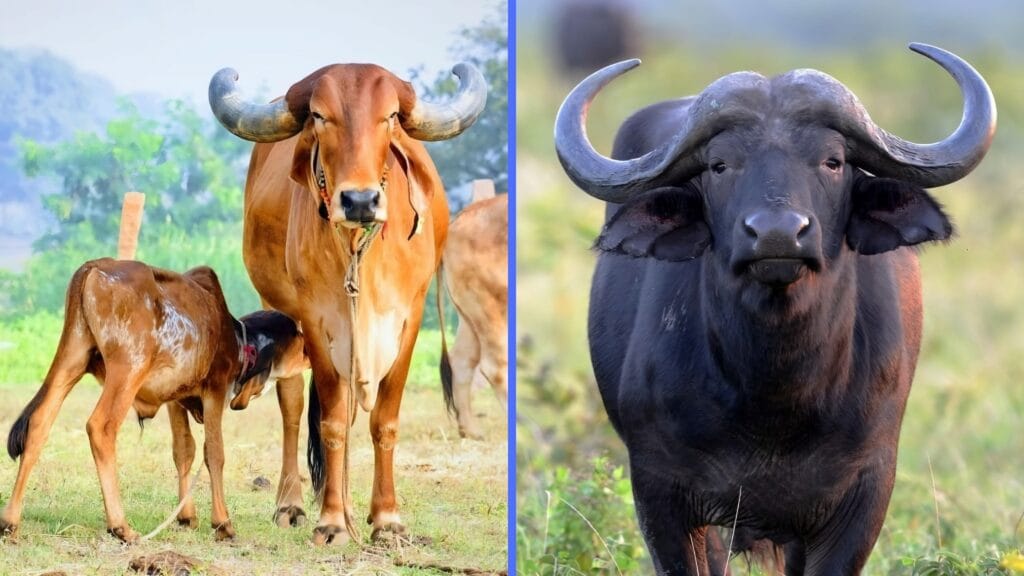
In recent years, the agricultural sector has gained renewed interest, with many looking to capitalize on the potential of livestock farming. If you have two cows and two buffaloes, you might wonder how these animals can generate a substantial income, such as ₹50,000 per month. This blog post will guide you through ten strategic ways to achieve this goal while emphasizing the importance of supporting local small businesses.
Whether you prefer online or offline methods, each strategy offers practical tips and real-world examples to help you succeed. Let’s dive into the world of dairy farming and discover how you can make the most of your livestock.
1. Dairy Production and Sale
Overview
One of the most traditional and reliable ways to earn from cows and buffaloes is through dairy production. The demand for milk and dairy products is consistently high, making this a stable income source.
Implementation Tips
- Quality Over Quantity: Ensure the health and nutrition of your animals to produce high-quality milk.
- Local Partnerships: Collaborate with local dairies or milk processors to ensure a steady market.
- Pricing Strategy: Consider competitive pricing while maintaining quality to attract more customers.
Real-World Example
In Punjab, a farmer named Rakesh transformed his small dairy farm into a lucrative business by focusing on organic milk production, attracting health-conscious consumers.
Relevant Statistics
According to the National Dairy Development Board, India produced over 187 million tonnes of milk in 2021, highlighting the vast potential of this market.
2. Organic Compost Production
Overview
With the growing interest in organic farming, producing and selling compost using cow and buffalo dung can be a profitable venture.
Implementation Tips
- Composting Techniques: Learn effective composting techniques to produce high-quality organic fertilizer.
- Target Audience: Focus on local farmers and gardening enthusiasts who prefer organic products.
- Marketing: Use word-of-mouth and local markets to promote your compost.
Real-World Example
An entrepreneur in Maharashtra initiated a compost business that now caters to local farms and urban gardening communities, significantly boosting his income.
Relevant Statistics
The global organic farming market is expected to grow at a CAGR of 8.2% from 2021 to 2026, indicating a rising demand for organic inputs.
3. Breeding and Selling Calves
Overview
Breeding your cows and buffaloes and selling the calves can be a lucrative business. This approach requires patience and understanding of genetics.
Implementation Tips
- Select Quality Breeds: Opt for high-yield and disease-resistant breeds.
- Health Management: Maintain a rigorous health-check routine for your animals.
- Networking: Connect with local farmers interested in purchasing quality calves.
Real-World Example
A farmer in Gujarat doubled his income by specializing in breeding Gir cows, known for their high milk yield and resilience.
Relevant Statistics
The livestock sector contributes about 4.11% to India’s GDP, showcasing the significance of breeding in the agricultural economy.
4. Online Dairy Subscription Services
Overview
Leverage technology by offering an online subscription service for your dairy products, providing convenience to consumers.
Implementation Tips
- User-Friendly Platform: Develop a simple online platform for orders and subscriptions.
- Customer Engagement: Use social media to engage customers and promote your service.
- Delivery Network: Establish a reliable delivery system to ensure timely product delivery.
Real-World Example
A start-up in Bangalore launched a successful milk delivery app, attracting urban consumers looking for fresh, organic milk.
Relevant Statistics
India’s online grocery market is projected to grow by 37.1% annually, highlighting the potential for online dairy sales.
5. Cheese and Yogurt Production
Overview
Diversifying your product range by producing cheese and yogurt can tap into niche markets and increase profitability.
Implementation Tips
- Skills Acquisition: Learn the art of cheese and yogurt making through workshops or online courses.
- Local Flavors: Incorporate local flavors and traditions to appeal to regional tastes.
- Retail Partnerships: Collaborate with local stores or cafes to stock your products.
Real-World Example
A small business owner in Kerala started producing traditional yogurt and paneer, gaining popularity in local markets.
Relevant Statistics
The Indian cheese market is expected to grow at a CAGR of 24% by 2025, offering vast opportunities for small producers.
6. Educational Farm Tours
Overview
Offer educational tours of your farm to schools and families, providing a unique experience and generating additional income.
Implementation Tips
- Interactive Learning: Develop engaging activities that educate visitors about dairy farming and animal care.
- Safety First: Ensure all safety measures are in place for visitors.
- Community Involvement: Partner with local schools and organizations to promote tours.
Real-World Example
A farmer in Rajasthan developed a popular farm tour program, attracting tourists and local schools, thereby raising awareness about sustainable farming.
Relevant Statistics
Educational tourism is on the rise, with more people seeking learning experiences during travel. This trend offers new opportunities for farm-based education.
7. Biogas Production
Overview
Convert cow and buffalo dung into biogas, an eco-friendly energy source, and sell it to local communities.
Implementation Tips
- Set-Up: Invest in a biogas plant and learn the basics of biogas production.
- Community Awareness: Educate local residents about the benefits of biogas.
- Distribution Network: Establish connections with local businesses or households for regular supply.
Real-World Example
In Haryana, a small farmer installed a biogas plant, reducing his energy costs and providing surplus energy to neighbors.
Relevant Statistics
India’s biogas market is expected to grow due to increasing government support and awareness about sustainable energy solutions.
8. Support Local Small Businesses
Overview
Collaborate with local small businesses by supplying them with dairy products or compost, promoting mutual growth.
Implementation Tips
- Networking: Attend local business events to build relationships with other entrepreneurs.
- Joint Ventures: Explore joint ventures, like offering package deals with local grocers or cafes.
- Community Focus: Highlight the community benefits of supporting local businesses in your marketing.
Real-World Example
A dairy farm in Tamil Nadu partnered with a local bakery, providing fresh butter and milk, boosting sales for both businesses.
Relevant Statistics
Supporting local businesses can keep 48% of each purchase within the community, compared to 14% from national chains.
9. Animal Husbandry Consultancy
Overview
Offer consultancy services based on your expertise in animal husbandry to other farmers or new entrants in the field.
Implementation Tips
- Build Credibility: Share your success stories and expertise through blogs or social media.
- Workshops: Conduct workshops or webinars on animal care and farm management.
- Networking: Partner with local agricultural extension services to reach more clients.
Real-World Example
A farmer in Karnataka started offering consultancy services, helping others optimize their livestock operations, while creating an additional revenue stream.
Relevant Statistics
The consultancy market in India is growing, with an increasing number of farmers seeking expert advice to improve their practices.
10. Value-Added Dairy Products
Overview
Create value-added dairy products such as flavored milk, ghee, or sweets to cater to diverse consumer tastes.
Implementation Tips
- Innovation: Experiment with new recipes and flavors to attract different customer segments.
- Quality Assurance: Maintain high quality and hygiene standards in production.
- Market Research: Stay updated with trends and consumer preferences to adapt your offerings.
Real-World Example
A dairy entrepreneur in Uttar Pradesh launched a line of flavored lassi, quickly gaining popularity among young consumers.
Relevant Statistics
Value-added dairy products are seeing increased demand, driven by changing consumer preferences and urbanization.
Conclusion
Earning ₹50,000 per month with two cows and two buffaloes is achievable with strategic planning and dedication. By exploring both online and offline methods, you can diversify your income streams and support local small businesses in the process. As you embark on this journey, consider how each strategy can be tailored to fit your unique situation and community.
Thought-Provoking Questions
- How can you leverage local partnerships to enhance your business’s impact?
- What innovative products or services can you introduce to stand out in the market?
- How can you contribute to your community’s sustainability and economic growth through your farming efforts?
Supporting local small businesses not only benefits individual entrepreneurs but also strengthens the community as a whole. By focusing on quality, community engagement, and sustainability, you can build a successful business that thrives in the ever-evolving agricultural landscape.
Earning Money with Cows and Buffaloes: A Step-by-Step Guide
Raising livestock such as cows and buffaloes can be a lucrative business if managed properly. Here is a detailed plan to help you earn approximately ₹50,000 per month by managing two cows and two buffaloes.
Initial Investment
To start, you’ll need to consider the initial investment required for purchasing the animals, setting up a farm, and other essentials. Here’s a breakdown:
1. Purchasing Livestock
- Cows: ₹30,000 per cow x 2 = ₹60,000
- Buffaloes: ₹35,000 per buffalo x 2 = ₹70,000
- Total for Livestock: ₹130,000
2. Infrastructure
- Shelter/Barn Construction: ₹50,000
- Fencing and Security: ₹10,000
- Water Supply and Troughs: ₹5,000
- Total for Infrastructure: ₹65,000
3. Equipment and Supplies
- Milking Equipment: ₹10,000
- Feed and Nutritional Supplements (for 3 months): ₹15,000
- Veterinary Care and Insurance: ₹5,000
- Total for Equipment and Supplies: ₹30,000
Total Initial Investment: ₹225,000
Monthly Operating Costs
1. Feed and Nutrition
- Cows: ₹1,500 per cow x 2 = ₹3,000
- Buffaloes: ₹2,000 per buffalo x 2 = ₹4,000
- Total Feed Cost: ₹7,000
2. Labor
- Farmhand/Helper Salary: ₹8,000
3. Utilities and Maintenance
- Electricity and Water: ₹2,000
- Repairs and Maintenance: ₹1,000
- Total Utilities and Maintenance: ₹3,000
Total Monthly Costs: ₹18,000
Revenue Generation
1. Milk Production
- Average Milk Yield:
- Cows: 10 liters/day x 2 = 20 liters
- Buffaloes: 7 liters/day x 2 = 14 liters
- Total Milk Yield: 34 liters/day
- Selling Price:
- Average price: ₹40 per liter
- Monthly Revenue from Milk:
- 34 liters/day x ₹40/liter x 30 days = ₹40,800
2. Additional Income Streams
- Manure Sale: ₹5,000
- Byproducts and Other Services: ₹4,200
- Total Additional Income: ₹9,200
Total Monthly Revenue: ₹50,000
Step-by-Step Guide
Step 1: Research and Planning
- Conduct thorough research on livestock management.
- Understand the local market for milk and byproducts.
Step 2: Secure Funding
- Save or source funds for the initial investment.
- Consider loans or grants if needed.
Step 3: Purchase Livestock and Setup
- Buy healthy and high-yield breeds.
- Construct necessary infrastructure and purchase equipment.
Step 4: Daily Management
- Implement a feeding and milking schedule.
- Ensure regular veterinary check-ups.
Step 5: Marketing and Sales
- Build relationships with local dairy distributors and consumers.
- Explore additional income opportunities like selling manure or offering farm tours.
Step 6: Monitor and Adjust
- Track expenses and revenues monthly.
- Adjust operations based on yield and market conditions.
Conclusion
Earning money through farming requires dedication, proper management, and consistent effort. By following this structured plan, you can achieve your goal of earning ₹50,000 per month, while also contributing positively to your local community and economy.


